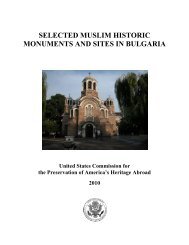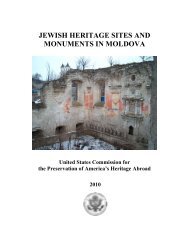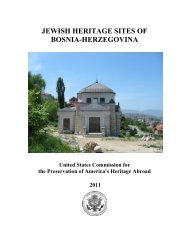jewish cemeteries, synagogues, and mass grave sites in ukraine
jewish cemeteries, synagogues, and mass grave sites in ukraine
jewish cemeteries, synagogues, and mass grave sites in ukraine
You also want an ePaper? Increase the reach of your titles
YUMPU automatically turns print PDFs into web optimized ePapers that Google loves.
‣ Cemeteries with no <strong>in</strong> situ <strong>grave</strong>stones, but where the boundaries have been determ<strong>in</strong>ed<br />
through research <strong>and</strong> the site has been cleared <strong>and</strong> fenced. Examples <strong>in</strong>clude Komarno <strong>and</strong> Sasiv<br />
(Lvivska oblast). In both cases, new ohels have been erected on the presumed <strong>sites</strong> of earlier<br />
structures (ohels are small permanent structures built to protect special <strong>grave</strong>s, traditionally<br />
reserved for <strong>grave</strong>s of venerated rabbis <strong>and</strong> scholars). In Belz (Lvivska oblast), some stones<br />
have been raised <strong>and</strong> others lie <strong>in</strong> the field (figure 46). No ohel has been built, but the site is<br />
fenced.<br />
‣ Cemeteries where substantial numbers of orig<strong>in</strong>al <strong>grave</strong>stones clearly <strong>in</strong>dicate the <strong>sites</strong> as<br />
a Jewish cemetery, but no protective measures are taken to preserve the site. Examples of such<br />
places <strong>in</strong>clude Busk (Lvivska oblast) (figures 4, 5, 50), Deliatyn (Ivano-Frankivska oblast), <strong>and</strong><br />
Sataniv (Khmelnytska oblast).<br />
‣ Cemeteries where substantial numbers of <strong>grave</strong>stones rema<strong>in</strong>, <strong>and</strong> all or part of the<br />
orig<strong>in</strong>al cemetery has <strong>in</strong> some way been fenced or protected. Such <strong>sites</strong> <strong>in</strong>clude Brody (Lvivska<br />
oblast), Medzhybizh (Khmelnytska oblast) (figures 11, 45) <strong>and</strong> Ternopil (Ternopilska oblast).<br />
‣ The troubled history of Ukra<strong>in</strong>ian Jewish <strong>cemeteries</strong> is perhaps typified by the fate of the<br />
cemetery <strong>in</strong> Ostroh (Rivnenska oblast). The old Jewish cemetery survived the Second World<br />
War, only to be demolished by the Soviets <strong>in</strong> 1961 to make way for a dance hall, which was later<br />
demolished after <strong>in</strong>dependence. Now, the site is a l<strong>and</strong>scaped park with memorials <strong>and</strong> a s<strong>in</strong>gle<br />
<strong>grave</strong> memorializ<strong>in</strong>g Solomon Luria (see note 46). A simple elegant entry gate leads to a<br />
memorial stone, <strong>in</strong>scribed <strong>in</strong> Yiddish <strong>and</strong> Ukra<strong>in</strong>ian (figure 49).<br />
50









